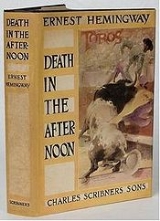
Death in the Afternoon
Encyclopedia
Death in the Afternoon is a non-fiction
book by Ernest Hemingway
about the ceremony and traditions of Spanish bullfighting
. It was originally published in 1932. The book provides a look at the history and what Hemingway considers the magnificence of bullfighting. It also contains a deeper contemplation on the nature of fear and courage.
 Hemingway became a bullfighting aficionado after seeing the Pamplona fiesta in the 1920s, which he wrote about in The Sun Also Rises
Hemingway became a bullfighting aficionado after seeing the Pamplona fiesta in the 1920s, which he wrote about in The Sun Also Rises
. In Death in the Afternoon, Hemingway explores the metaphysics of bullfighting—the ritualized, almost religious practice—that he considered analgous to the writer's search for meaning and the essence of life. In bullfighting, he found the elemental nature of life and death. In his writings on Spain, he was influenced by the Spanish master Pío Baroja
. When Hemingway won the Nobel Prize, he traveled to see Baroja, then on his death bed, specifically to tell him he thought Baroja deserved the prize more than he. Baroja agreed and something of the usual Hemingway tiff with another writer ensued despite his original good intentions.
Death in the Afternoon was published by Scribner's on 23 September 1932 to a first edition
print run of approximately 10,000 copies.
Non-fiction
Non-fiction is the form of any narrative, account, or other communicative work whose assertions and descriptions are understood to be fact...
book by Ernest Hemingway
Ernest Hemingway
Ernest Miller Hemingway was an American author and journalist. His economic and understated style had a strong influence on 20th-century fiction, while his life of adventure and his public image influenced later generations. Hemingway produced most of his work between the mid-1920s and the...
about the ceremony and traditions of Spanish bullfighting
Bullfighting
Bullfighting is a traditional spectacle of Spain, Portugal, southern France and some Latin American countries , in which one or more bulls are baited in a bullring for sport and entertainment...
. It was originally published in 1932. The book provides a look at the history and what Hemingway considers the magnificence of bullfighting. It also contains a deeper contemplation on the nature of fear and courage.
Contents
Any discussion concerning bullfighting would be incomplete without some mention of the controversy surrounding it. Toward that end Hemingway commented, "anything capable of arousing passion in its favor will surely raise as much passion against it."
The Sun Also Rises
The Sun Also Rises is a 1926 novel written by American author Ernest Hemingway about a group of American and British expatriates who travel from Paris to the Festival of San Fermín in Pamplona to watch the running of the bulls and the bullfights. An early and enduring modernist novel, it received...
. In Death in the Afternoon, Hemingway explores the metaphysics of bullfighting—the ritualized, almost religious practice—that he considered analgous to the writer's search for meaning and the essence of life. In bullfighting, he found the elemental nature of life and death. In his writings on Spain, he was influenced by the Spanish master Pío Baroja
Pío Baroja
Pío Baroja y Nessi was a Spanish Basque writer, one of the key novelists of the Generation of '98. He was a member of an illustrious family, his brother Ricardo was a painter, writer and engraver, and his nephew Julio Caro Baroja, son of his younger sister Carmen, was a well known...
. When Hemingway won the Nobel Prize, he traveled to see Baroja, then on his death bed, specifically to tell him he thought Baroja deserved the prize more than he. Baroja agreed and something of the usual Hemingway tiff with another writer ensued despite his original good intentions.
Death in the Afternoon was published by Scribner's on 23 September 1932 to a first edition
First edition
The bibliographical definition of an edition includes all copies of a book printed “from substantially the same setting of type,” including all minor typographical variants.- First edition :...
print run of approximately 10,000 copies.
External links
- Hemingway Archives, John F. Kennedy LibraryJohn F. Kennedy LibraryThe John F. Kennedy Presidential Library and Museum is the presidential library and museum of the 35th President of the United States, John F. Kennedy. It is located on Columbia Point in the Dorchester neighborhood of Boston, Massachusetts, USA, next to the Boston campus of the University of...

